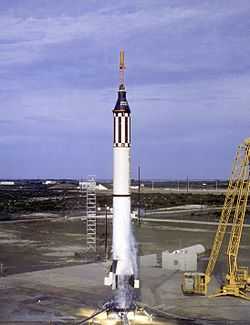Cape Canaveral Air Force Station Launch Complex 5
|
Mercury-Redstone 1 at LC-5 in 1960 | |
| Launch site | CCAFS |
|---|---|
| Location | 28°26′22″N 80°34′24″W / 28.43944°N 80.57333°WCoordinates: 28°26′22″N 80°34′24″W / 28.43944°N 80.57333°W |
| Short name | LC-5 |
| Operator | U.S. Air Force |
| Launch pad(s) | One |
| Launch history | |
| Status | Demolished |
| Launches | 23 |
| First launch | 19 July 1956 |
| Last launch | 21 July 1961 |
| Associated rockets | Jupiter-A Jupiter-C PGM-19 Jupiter Juno I PGM-11 Redstone Juno II Redstone MRLV |
Launch Complex 5 (LC-5) was a launch site at Cape Canaveral Air Force Station, Florida used for various Redstone and Jupiter launches.
It is most well known as the launch site for NASA's 1961 suborbital Mercury-Redstone 3 flight, which made Alan Shepard the first American in space. It was also the launch site of Gus Grissom’s Mercury-Redstone 4 flight. The Mercury-Redstone 1 pad abort, Mercury-Redstone 1A, and Mercury-Redstone 2, with chimpanzee Ham aboard, also used LC-5.
A total of 23 launches were conducted from LC-5: one Jupiter-A, six Jupiter IRBMs, one Jupiter-C, four Juno Is, four Juno IIs and seven Redstones. The first launch from the complex was a Jupiter-A on July 19, 1956 and the final launch was Gus Grissom's Liberty Bell 7 capsule on July 21, 1961.[1]
LC-5 is located next to the Air Force Space & Missile Museum. The original consoles used to launch the Mercury-Redstone rockets are on display in the blockhouse. As of 2011 a tour of the blockhouse (and the museum) can be arranged through the Kennedy Space Center Visitor Complex's "Cape Canaveral: Then and Now" tour. One tour is offered daily, so the number of visitors is limited by the size of the tour.
Launch chronology
- July 19, 1956: Jupiter-A CC-13
- September 20, 1956: Jupiter-C RS-27
- March 1, 1957: Jupiter IRBM AM-1A
- April 26, 1957: Jupiter IRBM AM-1B
- May 31, 1957: Jupiter IRBM AM-1
- March 26, 1958: Juno I RS-24 (Explorer 3)
- May 17, 1958: Redstone RS-1002
- July 26, 1958: Juno I RS/CC-44 (Explorer 4)
- August 24, 1958: Juno I RS/CC-47 (Explorer 5)
- October 23, 1958: Juno I RS/CC-49 (Beacon 1)
- December 6, 1958: Juno II AM-11 (Pioneer 3)
- January 22, 1959: Jupiter IRBM CM-21
- March 3, 1959: Juno II AM-14 (Pioneer 4)
- May 14, 1959: Jupiter IRBM AM-17
- July 16, 1959: Juno II AM-16 (Explorer S-1, failed)
- August 27, 1959: Jupiter IRBM AM-19
- October 13, 1959: Juno II AM-19A (Explorer 7)
- November 21, 1960: Redstone MRLV-1 (MR-1)
- December 19, 1960: Redstone MRLV-3 (MR-1A)
- January 31, 1961: Redstone MRLV-2 (MR-2)
- March 24, 1961: Redstone MRLV-5 (MR-BD)
- May 5, 1961: Redstone MRLV-7 (MR-3)
- July 21, 1961: Redstone MRLV-8 (MR-4)
Gallery
-

Preparations on May 16, 1958 for the first PGM-11 Redstone launch on May 17 conducted by US Army troops
-

Launch of Liberty Bell 7 (MR-4)
-

Blockhouse (2010)
-

Firing button (2010)
-

LC-5 with display Redstone (2010)
-

LC 5&6 blockhouse (now museum)
See also
- Air Force Space & Missile Museum
- List of Cape Canaveral and Merritt Island launch sites
- Project Mercury
- Jupiter
- Redstone
- Cape Canaveral Air Force Station Launch Complex 6 - used the same blockhouse
Notes
External links
| ||||||||||||||
| ||||||||||||||||||||||||||||||||||||||||||||||||||||||||||||||||||


